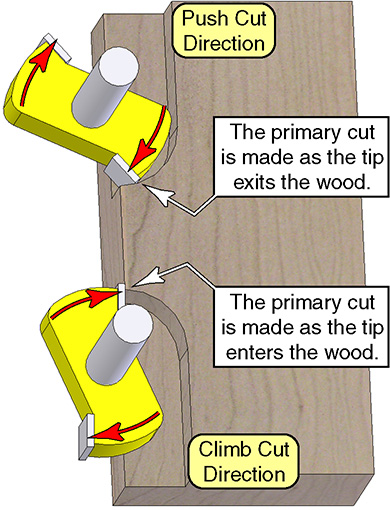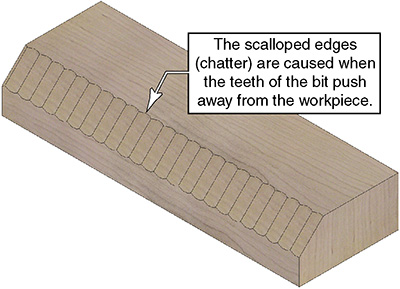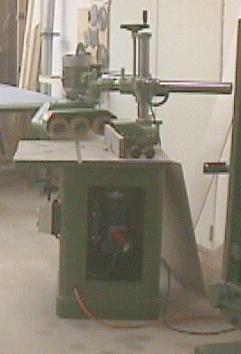Climb-Cutting Versus
Chip-Cutting
By Rick Christopherson
So you've built this beautiful jewelry box. Now comes the moment
to add the finishing touches, like routing a nice decorative profile
around the top. ----Craaaack!----There goes a 3 inch long chip from
the edge, destroying many hours of work.
You can prevent tearout when using a router; its just a matter of
the feed direction. There are two choices when it comes to the feed
direction with a router: Climb-Cutting, and Push-Cutting.
Push-Cutting
Push-cutting refers to the feed direction of your workpiece
which opposes the rotation of the cutter head.  Push-cutting is
typically considered the "normal" feed direction because it is
safest: the router doesn't want to runaway on you. However, push-cutting has the greater tendency for tearout. As the
carbide tip strikes the wood, the path of the cutter travel is
out of the wood, and the deepest cut is in-line with
the grain. The result, is that the carbide is cutting the wood on the
Exit Stroke.
Push-cutting is
typically considered the "normal" feed direction because it is
safest: the router doesn't want to runaway on you. However, push-cutting has the greater tendency for tearout. As the
carbide tip strikes the wood, the path of the cutter travel is
out of the wood, and the deepest cut is in-line with
the grain. The result, is that the carbide is cutting the wood on the
Exit Stroke.
The drawback to this direction, is that it tends to tearout the
wood more, because the wood fibers will easily split lengthwise. As
the cutter catches each fiber, it tends to pull it away from the main
body of wood.
At the same time as the wood fibers are being pulled away
from each other, the cutter head is being pulled deeper into
the main body of wood. If the cutter has a bearing, this direction of
cut will have the tendency to force the router to ride into the
bearing (or fence) more.
In the push-cut direction, chatter is reduced because the router
bit is applying a steady inward force to the cut.
Climb-Cutting
Climb-Cutting is when the feed direction of the workpiece is the same
as the rotation of the cutter. The term climb-cut comes from
the fact that the router bit has the tendency to climb into the cut,
or if you can visualize it, "walk" its way down a board. This is what
makes climb-cutting so dangerous: the router bit has more control
over the feed rate than you do, and if you don't carefully control
it, the router or workpiece will take off on you.
Putting aside the dangers, the primary benefit to climb-cutting is
that there is less, or even zero tearout. This is because the carbide
strikes the wood with the deepest portion of the cut cross-grained
and into the wood. That is to say, the carbide is
cutting the wood on the Entry Stroke, which is compressing
the wood fibers versus pulling them apart.
Aside from wanting to climb its way down the board, another side
effect of climb-cutting is that the bit will be pushed away from the
wood. As the carbide enters the wood, the force of the tip striking
the wood surface tends to push the wood away from the bit. This has
two effects. First off, the cut will almost never be full depth on
the first pass of the cut. Secondly, since the cutter tips keep
pushing the bit away from the wood twice per bit revolution, you end
up with more chatter. This chatter is caused from the cutter bouncing
in and out as each knife strikes the wood.
Applying These Concepts
The First Pass
To reduce the tearout while routing, I make the first pass in the
climb-cut direction. To prevent the router from running away on me, I
make this pass rather light. Since the router bit is naturally pushed
away from the wood during climb-cutting, making a light pass is
automatic: I just don't apply as much inward force.
Furthermore, I use friction to control the feed rate, not
muscle. When you try to muscle the router to control the feed rate,
then you are relying on your reaction time to compensate for
changes in the feed rate. You can never react fast enough.
With friction, there is no reaction time needed, there is just a
constant force opposing the climb. While holding the router's handle,
the butt of my fist is pressed down firmly onto the surface of the
wood. When starting or stopping a cut, I firmly plant my fist on the
wood, and use the other hand to rotate into or out of the cut. This
gives me very good speed control over a short distance. As I move
down a long board, I just drag the edge of my fist (or even forearm)
down the wood.
I won't climb-cut with a router bit that is too large to safely
control. For larger bits that aren't too large, or anytime I don't
feel completely in control, then I will plant my fist in one spot and
make short, shallow strokes by rotating the router into the cut with
the other hand.
Cleanup Pass
After the first pass, I make a cleanup pass in the chip-cut
direction. This ensures that the route went full depth, and also
removes the chatter marks left by the climb-cut. Because the majority
of the material has already been removed, the direction that the
carbide tips strike the wood is nearly parallel to the grain, and
therefore, no chipping occurs. I also make this last pass with a
fairly fast feed rate to ensure that there is no burning.
Using a Router in a Table When hand feeding stock
through the shaper or table mounted router, don't even consider
climb-cutting: It's a good way to lose a finger. You have no way
to control the feed rate when you are moving the workpiece on a
table. While you may think you can stop the piece from grabbing and
taking off, you can't.
If you have a power feeder for the shaper/router table, then
climb-cutting is feasible, but still very dangerous. My shaper is
setup to do 95% climb-cutting, but I have a rather large power feeder
(shown in the adjacent photo). The small "baby" power feeders, may
not provide enough workpiece control for climb-cutting. Regardless
of your feeder size, this is still dangerous. Never allow anyone to
stand in the outfeed path.
Most of the time, I do not need a cleanup pass on the shaper, but
the smaller the feeder, the more important this will be. If a cleanup
pass is needed, you can either change the feed direction to chip-cut,
or leave it in the climb-cut. I usually stay in the climb-cut
direction.
Conclusion Don't perform any operation just
because someone else has done it without problems. Regardless what
you do, or how you do it, routers and shapers are dangerous tools.
You must operate them with 100% confidence, but never let your
respect for them drop either. Operate the tool with respect.
Never, never, operate a tool when you have a "fear" of the tool, or
operation. There is a thin line between respect, and fear. Don't
cross that line, or you will be injured.
If you found this article from a search engine, and would like to
jump to the Waterfront Woods Home page, click on the image below.

 Email
Rick Christopherson
Email
Rick Christopherson

 Push-cutting is
typically considered the "normal" feed direction because it is
safest: the router doesn't want to runaway on you. However, push-cutting has the greater tendency for tearout. As the
carbide tip strikes the wood, the path of the cutter travel is
out of the wood, and the deepest cut is in-line with
the grain. The result, is that the carbide is cutting the wood on the
Exit Stroke.
Push-cutting is
typically considered the "normal" feed direction because it is
safest: the router doesn't want to runaway on you. However, push-cutting has the greater tendency for tearout. As the
carbide tip strikes the wood, the path of the cutter travel is
out of the wood, and the deepest cut is in-line with
the grain. The result, is that the carbide is cutting the wood on the
Exit Stroke.

